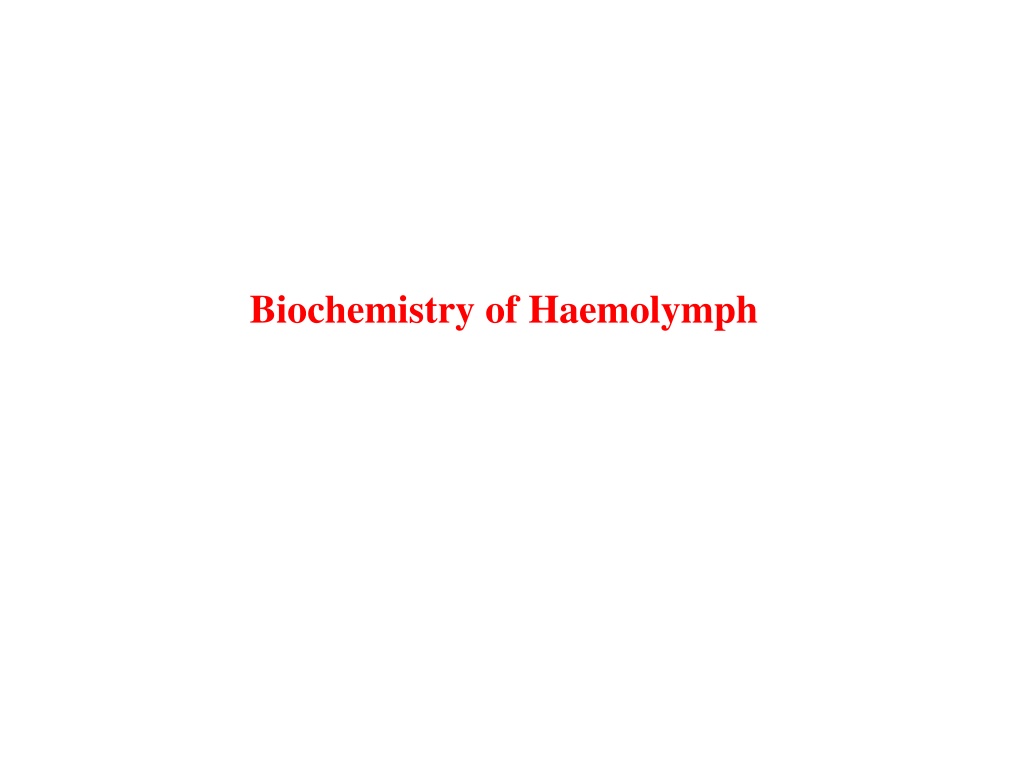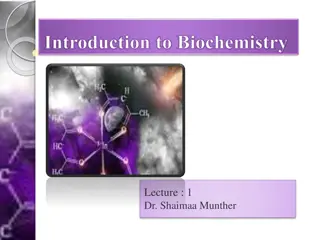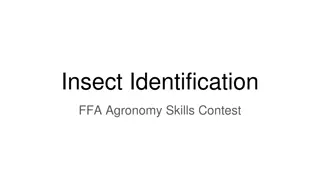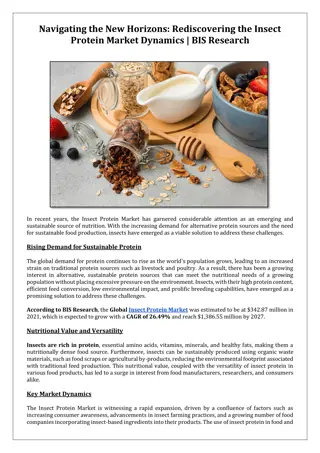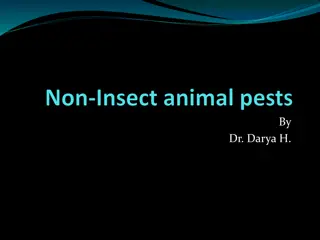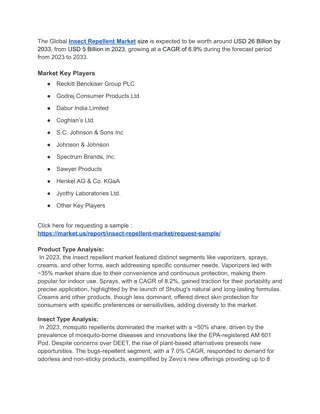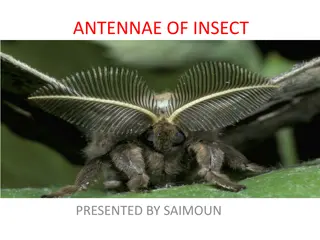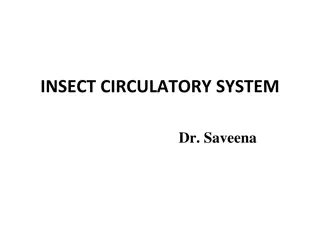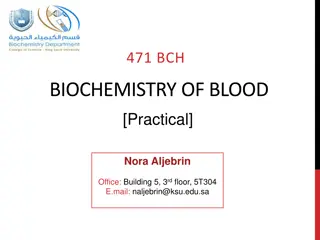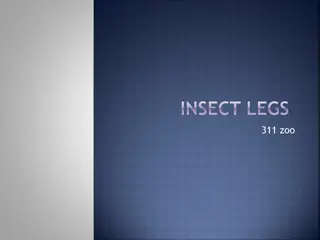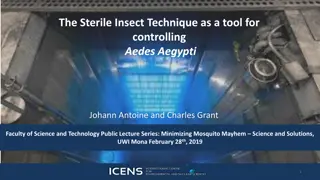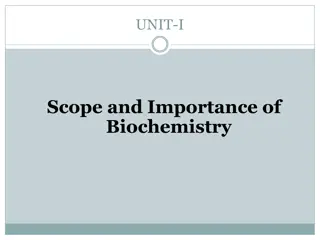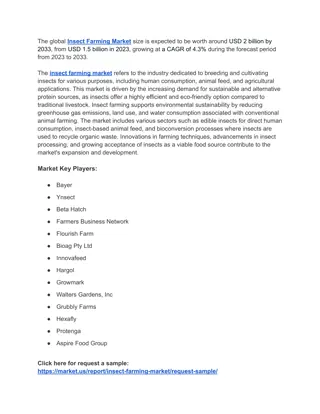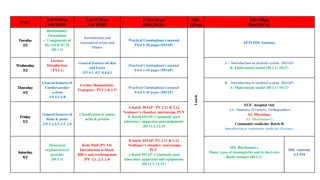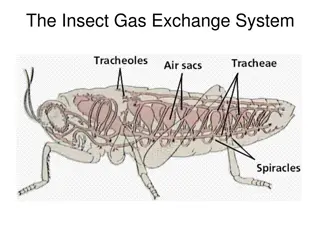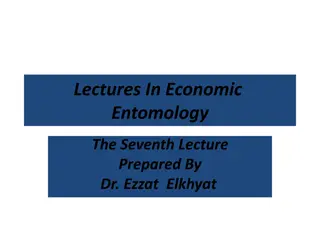Understanding the Biochemistry of Insect Hemolymph
Insect hemolymph, also known as blood, plays a crucial role in maintaining the tissues throughout the body. It consists of plasma containing hemocytes suspended in a fluid rich in various chemicals. The pH of the hemolymph ranges between 6.4 and 6.8, with variations in volume across different insect species and physiological states. The constituents of the plasma include inorganic ions such as chloride, sodium, potassium, and magnesium. Understanding the biochemistry of hemolymph provides insights into the physiological processes in insects.
Download Presentation

Please find below an Image/Link to download the presentation.
The content on the website is provided AS IS for your information and personal use only. It may not be sold, licensed, or shared on other websites without obtaining consent from the author. Download presentation by click this link. If you encounter any issues during the download, it is possible that the publisher has removed the file from their server.
E N D
Presentation Transcript
Haemolymph The blood, or hemolymph, circulates round the body, bathing the tissues directly It consists of a fluid plasma in which blood cells, hemocytes, are suspended The plasma, because of its function of maintaining the tissues throughout the body, contains many chemicals Plasma contain 85% water, is usually slightly acidic and includes inorganic ions, proteins, amino acids, fats, sugars organic acids and other substances in variable amounts The pH of insect hemolymph is usually between 6.4 and 6.8, although slightly alkaline values have been recorded in a dragonfly larva and in the larva of the midge, Chironomus
Hemolymph volume It is expressed as a percentage of the total body weight of the insect, varies with insect species and physiological state significantly, eg: I. Tenebrionid beetle, Onymachus, blood constitutes about 11% of the total body mass II. In mid-stadium larvae of Locusta, it is about 18%, while in adults it is about 12% III. In cockroaches it is about 17% IV. In caterpillars 35 40% Hemolymph water comprises 20 25% of the total body water in adult insects, but in caterpillars, the figure is close to 50%; this reflects the important hydrostatic function of the hemolymph in these larval forms; this role is further evidenced in other insects at the time of the molt where an increase in hemolymph volume occurs before each ecdysis. Before each molt of the desert locust, Schistocerca, the relative blood volume almost doubles, and is then reduced again after the molt In Periplaneta, the pre-molt increase in volume is associated with an increase in activity of an antidiuretic hormone and the post-ecdysial fall in volume is produced by a transient rise in the hemolymph titer of diuretic hormone
Constituents of the plasma Inorganic constituents Chloride is the most abundant inorganic anion in insect blood It is present in high concentrations in Apterygota and hemimetabolous insects, but is characteristically low in holometabolous insects, usually amounting to less than 10% of the total osmolar concentration Other inorganic anions present are carbonates and phosphates The most abundant cation is usually sodium although the amount varies with the insect s phylogeny and its diet Most phytophagous insects have lower concentrations of sodium than insects with other feeding habits; potassium and magnesium levels tend to be higher in phytophagous groups reflecting the levels of these elements in plant tissues
Major inorganic ions in the hemolymph of different insects (concentrations in mequiv./lit. or mmol/lit)
Amino Acids Insect blood plasma is characterized by very high levels of free amino acids; the total concentration in plasma is usually more than 6 mg per ml in endopterygotes, but less than this in exopterygotes Most of the protein amino acids are present, but their concentrations vary greatly from insect to insect; in endopterygotes glutamine and proline are present in high concentrations relative to most other amino acids; Glutamate (glutamic acid), on the other hand, is only present in very small quantities The concentrations of amino acids may change at different stages of the life cycle. Tyrosine, for instance, commonly accumulates before each molt and then decreases sharply as it is used in tanning and melanization of the new cuticle Glycine is one of the major amino acids in the blood of Bombyx mori towards the end of feeding stage but it decline after spinning as it is the major constituent of silk
Proteins Insect hemolymph plasma contains many different proteins with a variety of functions The total quantity of protein in the blood varies in the course of development, but peak concentrations in the late larval stages These proteins are usually classified by function and they are grouped as storage proteins, lipid transport proteins, vitellogenins, enzymes, proteinase inhibitors, chromoproteins, and a range of different proteins that are probably involved in the immune responses of insects
Other Organic Constituents Products of nitrogen metabolism like uric acid, ammonia, urea, and allantoin Various peptides and biogenic amines, acting as neurohormones or neuromodulators are always present Hormones, such as ecdysone and juvenile hormone, occur periodically Carbohydrates like Trehalose, a disaccharide is the most characteristic sugar found in insect hemolymph; Glucose is also often present, usually in much lower concentrations; other carbohydrates are such as hexosamines involved in chitin synthesis and, sometimes, the sugar alcohol, inositol is also present Glycerol or Mannitol is probably always present, and, in insects able to tolerate freezing, the concentration may be very high The concentration of lipids in the hemolymph generally varies between about 1 and 5 mg per ml, but values approaching 15 mg per ml are achieved in insects, such as Locusta and Manduca, that use lipids as fuels for flight. Most of the lipid is in the form of diacylglycerols; these components are normally carried by lipophorins Organic acids like citrate, -ketoglutarate, succinate and malate are also present
